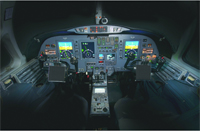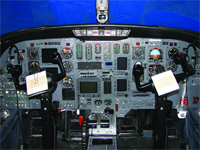
Features
Avionics
Suite upgrades: Knowing when it’s time to say goodbye or hang on for another day!
There is a familiarity and comfort that comes from older things. They have provenance, a proven track record, and make you feel comfortable.
January 30, 2008 By Rob Seaman
 |
| After – A Transport Canada Citation II after its avionics upgrade performed by MC2. Overall, this is considered to be one of the largest avionics upgrade programs ever undertaken, not only in Canada, but for the Citation II fleet globally. |
There is a familiarity and comfort that comes from older things. They have provenance, a proven track record, and make you feel comfortable.
Depending on your outlook, the same could be said for older business aircraft. Unfortunately, the truth is that nowhere else does the old saying “you can pay me now or pay me later” hold truer. Everything in aviation has a cost. When it comes to older airframes, while the initial acquisition price might seem like a bargain, the maintenance and upkeep, along with modernization can and will become an issue sooner or later. It all depends on your perspective.
So this raises the question – just when is the right time to say good-bye?
For some, this issue became a little more timely as the deadline loomed for the shutdown of Verizon’s (aka MagnaStar’s) ground-to-air flight phone system. Many will recognize this as the phone that sat in the seat headrest in front of you on North American airlines. There was a similar series of models designed for use with business aviation fleets. AirFone (as it was branded), competed openly with satellite-based alternatives. As recently as two years ago, new Magnastar AirFone units were still finding their way into the passenger area of corporate and commercial aircraft. Then Verizon announced that it would terminate the service by the end of 2007. Ever since, the units have been disappearing from the commercial fleets (in the case of Air Canada, being replaced with new headrest entertainment units).
On the corporate side, many of these now unsupported cabin phone systems can be converted to a full satcom – at a cost. Bill Arsenault, VP of Mid-Canada Mod Center (MC2), says performing this switch from ground-based to satellite-based technology ranges between $50,000 and $80,000. Some of the hardware remains the same while some requires changing. In the end, this is still less than getting a completely new system.
As for the money, it is really not much in the grand scheme of aircraft operations – and probably a no-brainer if you have a newer, modern product in your fleet. However if your bizjet “ride” happens to be an older Lear, Westwind, Saberliner or other similar “experienced” aircraft, you just might find this latest bill to be the straw that breaks the camel’s back.
Mike Payne is Embraer’s Executive Jets representative in Canada. He is able to relate easily to what drives folks to come to him for a new aircraft, and says avionics is at the top of the list. As Payne points out, regulations have changed and new equipment has been mandated. In his experience, many customers don’t want to invest in expensive new avionics or equipment such as flight phones on an old airframe. In general, aging aircraft require updating, and that is costly and time-consuming. In his recent experience, many customers want to get the benefits of lower operating costs that come with the newer, faster, more efficient airframes and engines. As others in the industry observe, and Payne agrees, an older aircraft can cost almost twice as much per flight hour as a newer one – especially when you start to factor in the upkeep, modernization and other general operational costs.
 |
| Before – The first Transport Canada Citation II as it arrived at MC2 in Toronto, December 2006. The overall layout and systems were dated – some going back to original delivery of the airframe. |
When it comes to money being spent on an older aircraft, one other consideration has to be the cost to finance the updating of the old, versus simply getting the new. Many on the financing side say the cost of borrowing against a much older aircraft can be unrealistic in comparison to getting new. The reasoning for this lies in the residuals that the finance com-panies allow on new aircraft. It is much higher on new vs. old. Some even go so far as to state that when you borrow to update an older aircraft, all you have done is add more investment into an aging and already depreciated asset. So it can be good money after bad.
Reliability and safety is another concern. Even though in most cases the standards for maintenance are very high and the overall industry record is very good, downtime is expensive and dispatch reliability is very important to corporate aircraft owners/operators. Old airplanes just seem to need that much more attention and care – and that costs money.
So any or all of these factors can and do come together to eventually drive an owner/operator to say enough – time to sell and get something new!
On the flip side there are occasions when it makes sense to invest one more time in “old faithful,” as it were. Such as last year in relation to an avionics upgrade for a fleet of nine Cessna Citation II aircraft and a level D flight simulator.
Transport Canada maintains a large fleet of fixed- and rotary-wing aircraft designated for civil aviation inspectors. The aircraft are used for a variety of work including inspections, verifying compliance with regulations or special-purpose flights, such as VIP travel. With regard to its Citation II fleet, it decided to perform a “mid-life avionics upgrade” after consideration of all options – including that of replacing the fleet with newer aircraft. In the end, Transport Canada turned to MC2 for the solution.
The original request for proposals specified that the avionics systems in the aircraft and simulator were being modernized to include:
a) One Class A Terrain Awareness Warning System (TAWS)
b) One Class II Traffic Collision Avoidance System (TCAS II)
c) One replacement Flight Management System (FMS)
d) An enhanced Electronic Flight Instrument System (EFIS)
e) An Airborne Traffic and Collision Avoidance System (ACAS II)
Various options that included an Electronic Standby Instrument System and the ability to display charts on the Navigation Display were also submitted.
Transport Canada specified an extensive bid and tender process – one that in this case included a full design and system spec with the layout as part of the submission. Overall, this is considered to be one of the largest avionics upgrade programs ever undertaken, not only in Canada, but for the Citation II fleet globally.
The final package that was STC’d in July of 2007 consists of Collins ProLine 21 avionics including a 3-screen EFIS, Weather Radar, full suite of Proline 21 radio sensors, Collins ACAS II, Collins IFIS-5000, Universal UNS-1F FMS, Universal Class A TAWS and L3 Avionics GH-3100 ESIS. The final configuration will replace the UNS-1F with a Universal UNS-1FW and add a stand-alone Universal WAAS sensor, when it becomes available. This will certify the aircraft for WAAS LPV approaches. The first aircraft arrived at MC2’s shop in Mississauga, Ont. in December 2006. One year later, four aircraft had been completed and pressed back into service while work on the fifth was well under way.
As for how this project worked out, Arsenault says the feedback to MC2 is that the client is extremely pleased. The aircrew report that the systems and overall outcome have made the aircraft much better in most aspects of its performance, easier to operate and that by and large the project has surpassed their expectations. So in this case investing in the old was just what was needed.
When all is said and done, the decision to keep or sell still remains one of personal choice. For everyone who will say “enough” and sell, there is equally another ready to say no, let’s make the upgrade and keep her going. And in the end, regardless of which way you turn, it means work for everyone at the OEM, maintenance and support levels.